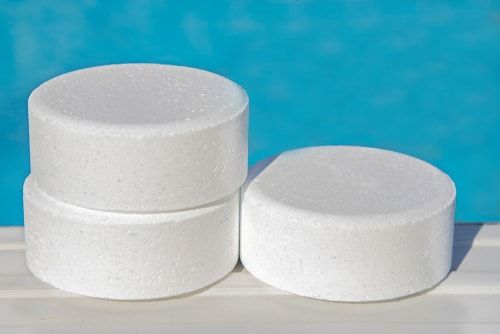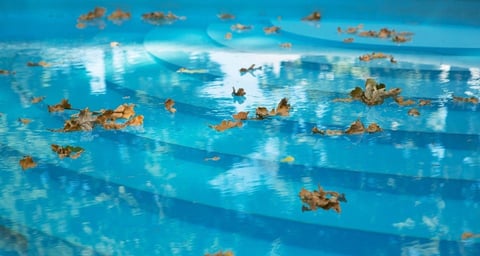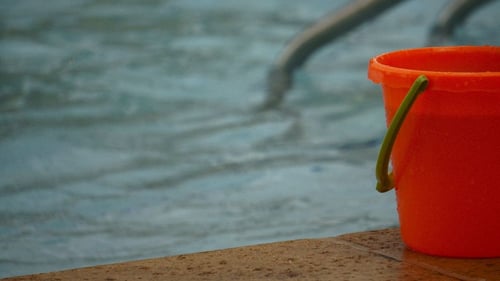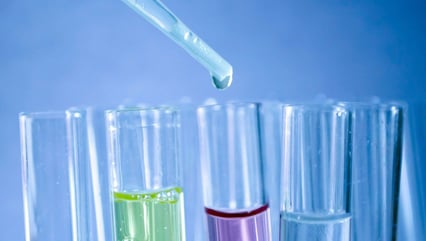Can I Use Bleach Instead of Chlorine to Clean My Swimming Pool?
May 11th, 2021
6 min read
By Alex Planes

We’re in unprecedented times, and that means answering unprecedented questions. One question I’d honestly not expected to hear is, “is it okay to use bleach to clean my pool?” But since the start of the year, I’ve seen folks asking about bleach in pool owner groups on Facebook, on our social media channels, on blogs and YouTube comments, in emails, and even in a few panicked phone calls here and there.
Why would you want to use bleach instead of pool chlorine?
If you’ve seen the news or tried to buy pool chlorine recently, you’ve probably noticed that there’s a chlorine shortage going on.
If you can find pool-grade chlorine, it’s probably a fair bit more expensive than you remember. If you can’t find any, you’ll still need some way to keep your pool clean.
Let’s take a look at the pros and cons of using bleach instead of chlorine in this article... but first, let’s start by exploring what bleach actually is and how it differs from the pool-grade chlorine you’re used to.
Bleach vs. pool chlorine: the basics
First, let’s clear something up: bleach is chlorine. Pool-grade chlorine and a jug of Clorox are essentially the same thing, chemically. However, they’re not made with the same concentrations of chlorine.

Pool-grade chlorine, which you can usually buy in tablets, granules, or as a liquid, tends to be available in formulations of between 65% and nearly 100% chlorine. Pure chlorine is known as hypochlorous acid.
Most popular pool-grade chlorine is formulated as calcium hypochlorite in granule or tablet form, which tends to be on the lower end of the concentration range. Many tablet-based treatments are formulated as trichloro-s-triazinetrione, or tri-chlor. A tri-chlor tablet can deliver nearly 100% pure chlorine when dissolved in pool water.
A jug of bleach, like Clorox, is mostly water. Bleach contains about 5% to 6% sodium hypochlorite, which means roughly 95% of your jug of bleach won’t do anything useful to clean your pool. Some bleach formulations may include colorings and fragrances, which can negatively affect the quality of your pool water.
Liquid chlorine treatments are also mostly water-based, but should typically have at least 10% sodium hypochlorite in a solution without unwanted color or fragrance additives.
Can you use bleach instead of chlorine?
Short answer: yes.
Longer answer: it depends on the formulation.
The label on every bleach bottle should tell you the ratio of sodium hypochlorite (and available chlorine) in the bottle to everything else. A higher percentage is generally better, as you’ll need to use less bleach to treat your pool.

You’ll also want a formulation with no fragrances or other chemicals. You shouldn’t be dyeing your pool water or making it smell like a summer breeze.
Many online retailers include label information for chemical products like bleach, so you can check both the chlorine concentration and for the presence of any other chemicals and/or additives before buying.
If you want to keep extra bleach around for future treatments, make sure you store it in a cool, dry place indoors. Don’t leave your bleach jugs outside!
How to use bleach to sanitize and disinfect your pool
Bleach, like any other kind of pool treatment, is best used in specific concentrations -- that is, you’ll want to be able to detect a certain amount of chlorine in your pool water. Too little, and you won’t effectively sanitize your pool water and surfaces. Too much, and your pool water might become too harsh to use.
The ideal range for added chlorine is between one and three parts per million -- that’s between 1-3 ppm in more scientific parlance. If you aim for 2 ppm, you should give yourself enough wiggle room in either direction.
Clorox itself recommends using between 100 and 200 ounces of regular-strength bleach per 10,000 gallons of pool water -- one gallon is 128 ounces, and many bottles of bleach are available in one-gallon or half-gallon sizes.

Pool professionals tend to recommend more conservative amounts of bleach. I’ve seen recommendations ranging from one quarter of a gallon per 10,000 gallons of pool water, which supposedly raises chlorine levels to 2.5 ppm, to one gallon per 30,000 gallons of pool water, for about 2 ppm of chlorine.
Most recommendations assume you’ll be using standard bleach, which is about 5% to 6% chlorine. If you’re using “concentrated” or “extra-strength” bleach, or any other formulation above the typical 5% to 6% ratio, you’ll need to use different amounts.
You might also want to consider using a salt water system instead of chlorine-based treatments. It can cost a bit to switch from chlorine to a salt chlorinator, but it might be a great long-term decision, both in terms of your maintenance costs and for your long-term enjoyment of your pool. Check our guide to the best pool salt water systems available today!
Stabilizers are important!
Remember when I told you to store your bleach indoors?
Chlorine breaks down when exposed to sunlight, which is why chlorine-based pool treatments tend to include an added stabilizer.
The most common chemical stabilizer for chlorine is cyanuric acid.
Adding cyanuric acid to your pool when you add bleach (or some other chlorine treatment) will prevent the chlorine from breaking down in sunlight and becoming useless for disinfection and sanitization. Most professionals recommend using about 30 ppm of cyanuric acid to stabilize the chlorine in your pool water.
Go slow and ask a pro
We strongly recommend asking a pool cleaning professional for advice before adding bleach, or anything else, to your pool water.

Always add any treatment in stages rather than all at once if you’re the least bit uncertain of your outcomes, and check chlorine levels with a chlorine test kit every time you add bleach or any other chlorine treatment.
Not sure how much bleach to add, because you’re not sure how many gallons of water are in your pool? Ask your pool builder!
If you'd like to get in touch with a pool builder today, whether it's to install a new pool or get the most out of the one you already have, click the button below and we'll connect you to an authorized River Pools franchise near you:
Fiberglass pool shells should include detailed dig specs with length, width, depth, and the volume of water (in gallons) it should hold when full.
For example, our D24 model has a 7,500-gallon capacity, while our C40 freeform model holds about 17,000 gallons. Concrete and vinyl liner pools may be a little trickier to estimate, but if you don’t mind doing a little math, you can use this formula to figure out your pool’s capacity...
Calculating the capacity of rectangular and/or freeform pools:
The formula for calculating the gallons in a generally rectangular pool, including freeform pools with more or less rectangular structures, is:
Length x width x average depth x 7.5
For example, a freeform pool like our I30 design is 30 feet long and 14 feet wide. Its depth ranges from 3’9” to 5’6” -- its average depth might be about 4’9”. With 12 inches in a foot, you need to calculate inches as a percentage of 12 rather than simply using the inches after your decimal point -- 9 of 12 is 0.75, so the calculation for the I30 is:
30 x 14 x 4.75 x 7.5 … or about 14,960 gallons. (14,962.5, to be exact.)
The I30’s true capacity is actually just 7,950 gallons, because it has a large tanning ledge and ample bench seating.
Most pools will probably have a true capacity well below the estimates you’ll get from this formula, because they’re also likely to have shallow-water features and forms that aren’t easy to measure or account for.
This is why it’s so important to ask your pool builder for accurate measurements, and why you should add bleach or other treatments in batches or stages, while testing your water after each round of added treatment.
Hire a pro or do it yourself?
You probably didn’t come here for the math. I get it. But if you want a clean, safe, enjoyable pool experience this summer, you will need to get your numbers right.
Sometimes it’s just easier and a lot less stressful to outsource pool maintenance to a professional cleaning service. Your hired pool guy should know how much bleach (or other chemicals) to add, how to stabilize it, how to test everything, and how to avoid wasting resources or turning your backyard oasis into a toxic stew.
But if you’d rather keep your pool clean on your own, you can still get help! There are a couple of highly useful pool-maintenance apps available for your smartphone or tablet:
These apps can help you add the right amount of any chemical to your pool, and you should also be able to track your chemical concentrations over time, in case you need to figure out why something went unexpectedly sideways one weekend.
Hopefully, this article helped you figure out what to do about your chlorine situation. If you have any questions -- and you probably do -- please reach out to your friendly neighborhood pool pros. A clean pool is a happy pool. Happy swimming!
At River Pools, we manufacture world-class fiberglass pools for customers across North America. If you're shopping around for a fiberglass pool, feel free to take a look at our catalog of models, visit our extensive video library, try out our pool cost calculator, or request custom pricing using the button below.


